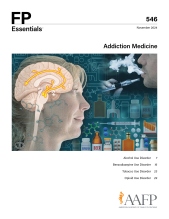
This clinical content conforms to AAFP criteria for CME.
The number one cause of preventable disease, disability, and death in the United States is tobacco use. According to data from the National Health Interview Survey, 18.7% of US adults (46 million people) currently use a tobacco product. Smoking causes lung, laryngeal, hepatocellular, and colorectal cancers and possibly breast cancer. Nicotine is the highly addictive component of tobacco that releases dopamine when it binds to alpha-4 beta-2 nicotinic acetylcholine receptors in the brain. This produces reward sensations that become associated with specific behaviors and relieves stress and negative emotions. Public policy changes, behavioral interventions, and pharmacologic approaches have been shown to reduce tobacco use. Combining behavior therapy with pharmacotherapy increases cessation rates. The US Food and Drug Administration has approved five nicotine replacement therapies and two no-nicotine oral medications to assist with smoking cessation. Medications are categorized as controllers or relievers based on their pharmacokinetics. Nicotine replacement therapy delivers lower amounts of nicotine and needs to be titrated to alleviate patient cravings. Varenicline is a selective partial agonist at the alpha-4 beta-2 nicotinic acetylcholine receptor and is recommended over bupropion for smoking cessation.
Case 3. KH is a 27-year-old patient who started smoking cigarettes at 14 years of age. Although she quit smoking in nursing school because her friends did not smoke, she started vaping nicotine instead. She believes that vaping is a safe alternative to smoking cigarettes. During her annual wellness examination, she discusses her desire to become pregnant within the next 3 years and that she would like to quit vaping when she becomes pregnant.
Subscribe
From $350- Immediate, unlimited access to FP Essentials content
- 60 CME credits/year
- AAFP app access
- Print delivery available
Edition Access
$44- Immediate, unlimited access to this edition's content
- 5 CME credits
- AAFP app access
- Print delivery available
